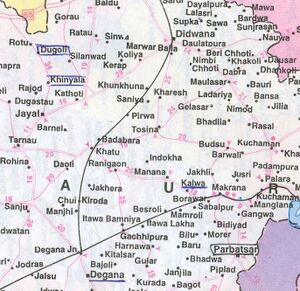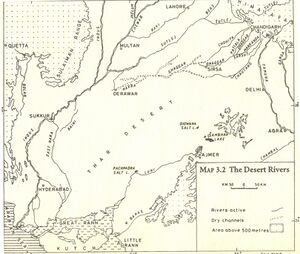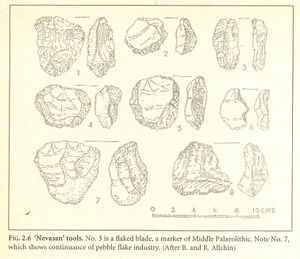Didwana Nagaur
Note - Please click → Didwana for details of similarly named villages at other places.


Didwana (डीडवाना) is a city and tehsil place in Rajasthan in Nagaur disatrict.
The Founders
It was founded by Dudi gotra Jats. It was their capital. Its ancient name was Dindiyanaka (डिंडियानक).
Villages in Didwana tahsil
Aas Ki Dhani (आस की ढाणी), Agoonta (आंगुन्ता), Agrot (अगरोठ), Ajawa (आजवा), Ajdoli (आजडोली), Akoda (आकोदा), Alakhpura (अलखपुरा), Amarpura (अमरपुरा), Ambapa (अम्बापा), Asalsar (आसलसर), Bagarwaliya (बगरवालिया), Bagatpura (बगतपुरा), Bajiyon Ki Dhani (बाजियों की ढाणी), Bakwas (बकवास), Baliya (बालिया), Bandolai Ki Dhani (बांडोलाई की ढाणी), Bansa (बांसा), Banthadi (बांठडी), Banwasa (बनवासा), Baori (बावङी), Barangana (बरांगना), Barawara (बडावरा), Bardawa Nagaur (बरड़वा), Beechawa (भींचावा), Begsar (बेगसर), Bemoth (बेमोट), Beri Khurd (बेरी खुर्द), Beri Kalan (बेरी कलां), Berwa (बैडवा), Bhadasar (भाडासर), Bhadliya (भदलिया), Bhamasi (भामासी), Bhandari (भण्डारी), Bhawad (भवाद), Bhawadiya Ki Dhani (भवादिया की ढ़ानी), Bhopji Ka Bas (भौपजी का बास), Bugaliyon Ki Dhani (बुगालियों की ढाणी), Burod (बुडोद), Chak (चक), Chand Basni (चांद बासनी), Chhapri Kalan (छापरी कलां), Chhapri Khurd (छापरी खुर्द), Cholookhan (चौलू खां), Chomu (चौमू), Chugni (चुगनी), Dabgaon (डाबगांव), Dabra (डाबडा), Dadhel (डढेल), Dadu Basni (दादू बासनी), Dakipura (डाकीपुरा), Dasana Kalan (डसाना कलां), Dasana Khurd (डसाना खुर्द), Daudsar (दाऊदसर), Daulatpura (दौलतपुरा), Dayalpura (दयालपुरा), Deendarpura (दीनदारपुरा), Deorathi (देवराठी), Dhaki Ki Dhani (ढाकी की ढाणी), Dhankoli (धनकोली), Dheegal (ढीगाल), Dhigariya (ढिगारिया), Didwana (डीडवाना) (M), Dikawa (डीकावा), Doodoli (दूदोली), Elichpura (ऐलिचपुरा), Ganeshpura (गणेशपुरा), Gaonri (गांवड़ी), Gardeja Basni (गरदेसा बासनी), Gawariyon Ki Dhani (गांवडियों की ढाणी), Girdharipura (गिरधारीपुरा), Godras (गोदरास), Indolav Ki Dhani (इंदोलाव की ढानी), Indrapura (इन्द्रपुरा), Jaitpura (जैतपुरा), Jakharon Ka Bas (जाखड़ों का बास), Jatanpura (जतनपुरा), Jewaliyawas (जैविलयावास), Jharod (झाडोद), Jorawarpura (जोरावरपुरा), Jodi Ka Bas (जोड़ी का बास), Kairap (कैराप), Kalwani (कलवाणी), Kalyanpura (कल्याणपुरा), Kanwai (कणवाई), Kaprod (कापडोद), Kayastha Basni (कायस्था बासनी), Keechak (कीचक), Khakholi (खाखोली), Khanri (खानडी), Khardiya (खारडिया), Kharesh (खरैश), Khariya (खारिया), Kharwaliya (खरवालिया), Khateera Ki Dhani (खातीङा की ढाणी), Khatiya Basni (खातिया बासनी), Khatu Khurd (खाटु खुर्द), Khichiya Basni (खिचिया बासनी), Khojas (खोजास), Khunkhuna (खुनखुना), Khuri (खुङी), Khuri Nimbi (खुङी निम्बी), Kishanpura (किशनपुरा), Kodiya (कोडिया), Koliya (कोलिया), Koniyara (कोनियाडा), Kuchetiya (कुचेटिया), Kunkana Ki Dhani (कुंकणा की ढाणी), Kurli (कुङली), Kuroli (कुङोली), Kyamsar (क्यामसर), Ladariya (लादड़िया), Ladawas (लाडाबास), Lakheepura (लखीपुरा), Lalasari (लालासरी), Lega Ki Dhani (लेगा की ढाणी), Loonoda (लूणोदा), Loroli (लौरोली), Loroli Kalan (लौरोली कलां), Loroli Khurd (लौरोली खुर्द), Madam (मदाम), Malla Basni (मल्ला बासनी), Mamroda (मामड़ोदा), Manaksar (माणकसर), Manda Basni (मण्डा बासनी), Mandookara (मण्डूकरा), Mawa (मावा), Molasar (मौलासर), Moriyawat (मोडियावट), Naurangpura (नौरंगपुरा), Netadon Ki Dhani (नेतड़ों की ढाणी), Nimba Ka Bas (निम्बा का बास), Nimbi Kalan (निम्बी कलां), Nimbi Khurd (निम्बी खुर्द), Nimod (निमोद), Ninawata (निनावटा), Nojloki Dhani (नोजलों की ढाणी), Noowa (नूवा), Nosar (नोसर), Palot (पालोट), Pandorai (पांडोराई), Paota (पावटा), Patan (पाटन), Pathanon Ka Bas (पठानों का बास), Pawa (पावा), Payli (पायली), Peedwa (पीड़वा), Peepala Ka Bas (पीपला का बास), Phogri (फोगडी), Pyawan (प्यावा), Raghunathpura (रघुनाथपुरा) Raisinghpura (रायिसंहपुरा), Ramsabas (रामसा बास), Ransisar (रणसीसर), Raseedpura (रसीदपुरा), Reeksabas (रिक्साबास), Ruwan (रूवां), Sagoo Kalan (सागू कलां), Sagoo Khurd (सागू खुर्द), Saniya (सानिया), Sardarpura Kalan (सरदारपुरा कलां), Sardarpura Khurd (सरदारपुरा खुर्द), Sekha Basni (शेखा बासनी), Sewa (सेवा), Sherani Abad (शेरानी आबाद), Singhana Didwana सिंघाना), Singrawat Kalan (सिंगरावट कलां), Singrawat Khurd (सिंगरावट खुर्द), Soopka (सूपका), Sudrasan (सुदरासन), Tarpura (तारपुरा), Thakariyas (ठाकरियास), Thanu (थाणु), Thebri (थेबडी), Tigoria (तिगारिया), Toliyasar (तुलियासर), Tosina (तोषिणा),
Jat Gotras
Geography
Didwana is located at 27.4 N & 74.57 E.[2] It has an average elevation of 336 metres (1102 feet).
The town is more than 5,000 years old and has long history of great teachers who have taken the Hindu Religion a long way and have shown the way how to lead life, how to grow etc.
In Didwana there are twelve Baas and twelve Baasni (called in general language Colony). There live mali samaj in these Baas and Deshwali samaj lives in Basani.
- Maidashar Bass
- Singhi Bass
- Kumaniya Bass
- Mohandas Bass
- Bhati Bass
- Heari Bass
- Gaadha Bass
- Harinarayan Bass
- Kadiya Bass
- Jhalara Bass
- Bari Bass
- Aadaka Bass
- Katala Bass
- Tiba Bass.
Thse are the famous twelve villages (Baasni) around Didwana, where Deshwali community lives.
- Ramsabas.
- Ladabas.
- Khatiabasni.
- Baliya.
- Amarpura.
- Gardejiabasni.
- Dadubasni.
- Shekhabasni.
- Khinchiyabasni.
- Mallabasni.
- Daulatpura.
- Katlabas.
Following are the famous Chowk in Didwana. Chowk means Locality.
- Mohallah Sayedan & Qauziyaan.
- Narsingh Chowk Near Nagoria Math.
- Shyam Ji Ka Chowk Near Shayam Ji Ka Mandir.
- Gaggro Ka Chowk.
- Bangur Chowk.
- Ghodawato Ka Chowk.
- Bhargav Chowk.
- Majejio Ka Chowk Near Jhalaria Math.
- Mathura Das Ji Ka Jaav in Gaadha Baas.
- Pathano Ki Paanch Pol.
Earlier this city was extent in-between Seven Big Gates, for security. But now six gates exist, as one (Delhi Gate) gate has vanished. One thing is special for these gates that at each gate The lord Ganesh Temple are situated. The name of gates are below:
- Nagori Gate.
- Ajmeri Gate.
- Kote Gate.
- Deen Darwaja.
- Khidki Darwaja, (Chapri Gate).
- Fatehpuri Gate.
- Delhi Gate, (this does not exist now).
The city was one of the most prominent town in the Rajastan State and important centre from people from nearby villages and towns as Ladnun, Kuchaman City, Merta, Sujangarh, Kishangarh, Maulasar, Budsoo etc.
Demographics
As of 2001 India census, Didwana had a population of 44,661. Males constitute 52% of the population and females 48%. Didwana has an average literacy rate of 58%, lower than the national average of 59.5%: male literacy is 70% and, female literacy is 46%. In Didwana, 17% of the population is under 6 years of age. Now this city will become the District Headquarters because most of the offices of district level has been opened and rest of office will be opened soon. name of Bass 1.madashar bass 2.singi bass 3.kumaniya bass 4.mohandas bass 5.bhati bass 6.heari bass 7.gadha bass 8.harinarian bass 9.kadiya bass 10.jalara bass 11.bari bass 12.aadaka bass 13.katala bass 14.tiba bass 15.mr.attitude nagar
Pre History

Irfan Habib[3] writes that...[p.26] Many sites in south India including Hunsgi valley in Karnataka, and Attirampakkam, near Chennai, have turned up “Early Acheulean tools” (of the so -
[p.27]: called 'Madras industry'), that is, hand axes, etc., made mainly from the cores (see Fig. 2.5).

The U-Th method has yielded dates going back to beyond 350,000 years for sites in Karnataka. Lower Palaeolithic artefacts at Didwana in Rajasthan have been dated by the same means to 390,000 years ago, and at Nevasa in Ahmadnagar district of Maharashtra to 350,000 years ago.
During this process of his diffusion there was a tendency over time for the original Homo erectus to evolve into sub-species that were less robust but more dexterous, and so could make smaller tools out of flakes or the 'Late Acheulean tools'. Remains of such tools have been found in the Narmada valley, where these appear in association with the 'Narmada skull' discovered at Hathnora. This skull, belonging to an evolved Homo erectus could date back to a time earlier than 130,000 years ago. At the famous cave of Bhimbetka in the same area, successive periods of occupation begin with the lowest floors containing Late Acheulean tools.
As Homo erectus evolved, he also improved his tools, giving them new shapes and adjusting the technique to locally available materials. Such changes occurred very slowly, over tens of thousands of years, but these ultimately led to the rise of regional 'cultures'. The term 'culture' is used when archaeologists find at a layer in one or more sites a similar assemblage of tools, ornaments and other products of human labour, which they call 'artefacts', as well as indications of similar customs and beliefs, such as systems of disposing of the dead, and ritual symbols. Regarding Homo erectus, there is little known of custom or belief, and the forms of his stone tools alone supply us with clues to his varied cultures. As the millennia passed, the tendency was for the production of smaller and thinner tools; and the apparently independent appearances of the flake blade in many parts of the world were a natural result of such a tendency. The flake blade is supposed to mark the Middle Palaeolithic stage in India. Such stone blades are found in the 'Nevasa culture' (named after the site of Nevasa already mentioned), which seems to have extended over the southern peninsula and central India (see Fig. 2.6).

At Didwana, the Middle Paeolithic is dated by the TL method to about 150.000 years, ago, but in Gujarat a date as late as 56,800 years ago has been obtained by the U-Th method. In Sri Lanka's southern wet zone, a range of 200,000 to 40,000 years ago has been suggested for it. So the culture may have lasted for a hundred thousand years, if not more. This culture is held to be in direct continuity with the Lower Palaeolithic; and, therefore, its authors were probably the direct descendants of the late Homo erectus, though no skeletal remains have yet been found at any of the sites.
History
The town is one of the Towns and Villages of Chauhan Dominions mentioned as Dindiyanaka (डिंडियानक) in Bhoja Pratihara's grant of V. 900 (843 AD).
As per local tradition Didwana was in existence for more than 2000 years ago. It is said that on samvat 318 (261 AD) baisakh krishna ashtami Shesh Ram Vanik's son Didushah founded the town and named Didwanaka which became Didwana. It is also mentioned as Abhanagari in ancient Inscriptions, which is the area around lake in the east of present town. Here an ancient monument of 'Sarki Mata Mandir' is there. Later on it came under the rule of Nath Sampraday, Kushans, Harshavardhana, Tomars and Chauhans. The Salt Industry of Didwana developed during the Chauhan rulers. After the Chauhans ruled Rathores of Toshina and Nagaur from samvat 1403-1424. Later on it came under Delhi, Jaipur, Bikaner and Jodhpur. [4]
Chittor Victory pillar Inscription of 1460 AD
चित्तौड़ के कीर्तिस्तम्भ प्रशस्ति १४६० ई. [5] में डीडवाना का उल्लेख है. जहां कुम्भा का वर्णन हमें मिलता है वहां यह उल्लिखित है कि माण्डव्यपुर (मंडोर) से हनुमान की मूर्ति लाया और १५१५ वि.सं. में उसकी स्थापना दुर्ग के प्रमुख द्वार पर की. इसके अनन्तर कुम्भा द्वारा सपादलक्ष, नराणा, वसंतपुर और आबू जीतने का वर्णन है. महाराणा ने एकलिंगजी के मन्दिर के पूर्व की ओर कुम्भ-मंडप का निर्माण कराया. आगे चलकर मालवा और गुजरात की और सेना के प्रयाण का वर्णन मिलता है जो बडा रोचक है. इसी तरह जांगल प्रदेश तथा धुंकराद्रि और खंडेला की विजय के उल्लेख के साथ लेखक ने उस भाग की नैसर्गिक स्थिति पर भी प्रकाश डाला है. श्लोक १४६ में किसी शत्रु के पुर से (?) गणेश -मूर्ति को यहां लाकर स्थापित करने का उल्लेख है. इसी में डीडवाना की नमक की खान से कर लेना तथा विशाल सैन्य से खंडेले को तोड़ना भी उल्लिखित है.
Notable persons
External links
References
- ↑ User:Harendrakeelka
- ↑ Falling Rain Genomics, Inc - Didwana
- ↑ People’s History of India 1, Prehistory, by Irfan Habib, Aligarh Historians Society, Published by Tulika Books, Second Edition, 2002, ISBN: 81-85229-68-6,p.26-27
- ↑ Dr. Raghavendra Singh Manohar:Rajasthan Ke Prachin Nagar Aur Kasbe, 2010, pp. 119-120
- ↑ डॉ गोपीनाथ शर्मा: 'राजस्थान के इतिहास के स्त्रोत', 1983, पृ.146-147
- ↑ Jat Gatha, September-2015,p. 15
Back to Places

